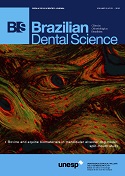Tooth abnormalities in pediatric patients submitted to antineoplastic treatment for central nervous system neoplasms
DOI:
https://doi.org/10.14295/bds.2016.v19i3.1263Abstract
Objective: The aim of this study was to evaluate the frequency of tooth abnormalities in pediatric patients treated for central nervous system neoplasms. Material and methods: This cross-sectional study assessed thirty-one patients, median age 14.2 years (range 5 - 25), who were off therapy for at least one year, comparatively with a control group of thirty-one healthy patients matched for age with the study group. Tooth abnormalities were evaluated by panoramic radiographs. Results: There was no statistical significant evidence that patients of the study group (age range 5 - 25 years) have more frequency of tooth abnormalities comparatively with controls. However, in children who were diagnosed before 5 years of age, microdontia was the most common abnormality with statistically significant difference (P=0.037). Root shortening grade III was observed in patients over 10 years of age at the time of radiographic examination, also with statistical significance (P=0.046). Conclusions: Tooth abnormalities frequency in patients treated for central nervous system neoplasms is directly related to the age of diagnosis and stage of odontogenesis. Microdontia and reduced root surface areas, the most common abnormalities observed, can lead to future oral health impairment due to malocclusion and less periodontal support. It is important to give parents and patients early orientation about maintenance of good oral hygiene and proper treatment by orthodontics or dentofacial orthopedics.Downloads
Downloads
Published
How to Cite
Issue
Section
License
Brazilian Dental Science uses the Creative Commons (CC-BY 4.0) license, thus preserving the integrity of articles in an open access environment. The journal allows the author to retain publishing rights without restrictions.
=================




























